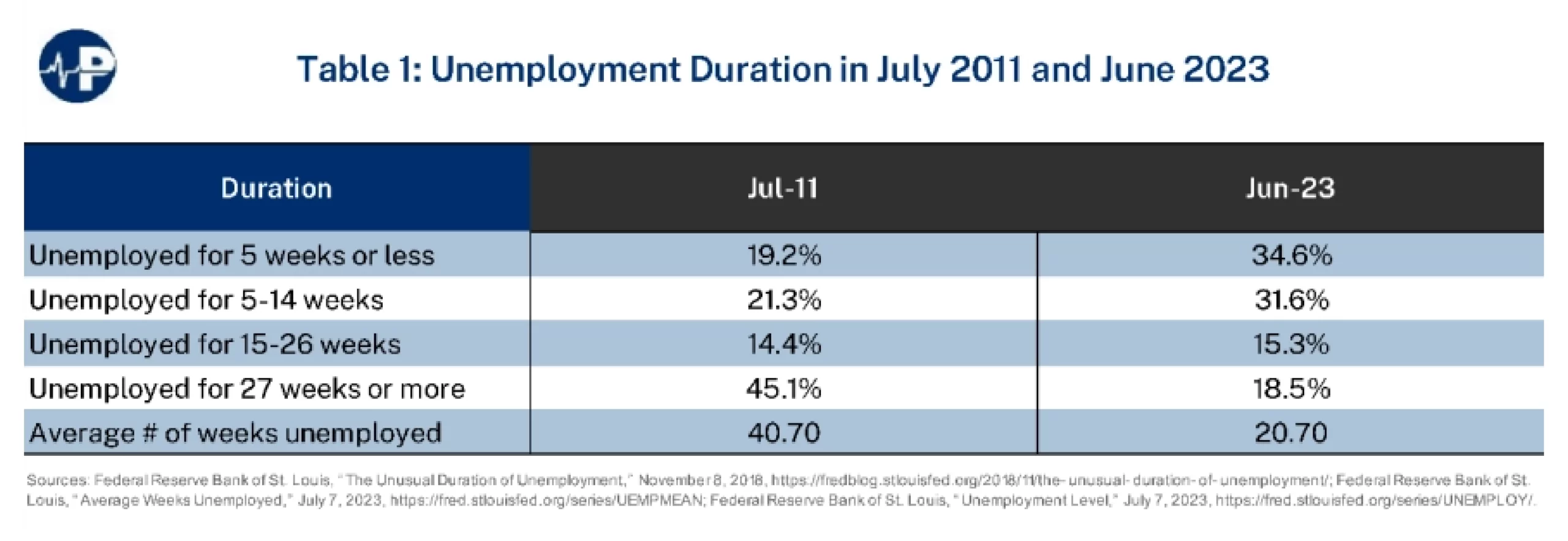On September 7, 2023, 40 policy experts signed a public comment letter that strongly urges the Biden Administration to withdraw a rule that proposes to limit the availability of short-term limited-duration health insurance. The letter is directed to HHS Secretary Xavier Becerra, Treasury Secretary Janet Yellen, and Acting Secretary of Labor Julie Su, and is signed by Tom Philipson, former chief CEA economist Casey Mulligan, and heads of public policy research centers Avik Roy, Tarren Bragdon, John Goodman, Grace-Marie Turner, Paul Winfree, and Sally Pipes (among others).
Dear Secretaries Becerra, Yellen, and Su:
The Departments’ proposal would restrict short-term limited-duration insurance (STLDI) contracts to three months (with an option to renew for just one single month) and impose additional restrictions on excepted benefits. The proposed rule is misguided, punishing, ill-timed, and potentially unlawful. This rule would reduce affordable options for families, strip coverage from sick people and leave them facing huge medical bills with no coverage and increase the number of uninsured individuals from anywhere between several hundred thousand people to millions of people per year. Ultimately, this rule creates clear losers and only speculative and minimal benefits.
The timing of this rule is particularly harmful given that states began determining Medicaid eligibility earlier this year, and 18 million people are expected to be removed from Medicaid between April 2023 and the summer of 2024. Several million of these individuals would potentially benefit from STLDI plans.
The overwhelming number of comments received by the Departments are from people who would be harmed by this proposed rule. The main beneficiaries would be health insurance companies that want to restrict alternative options, forcing Americans to buy heavily government-subsidized products (government subsidies cover roughly 80 percent of the premium for the average exchange enrollee) from them and not their unsubsidized competitors.
From a legal perspective, this rule radically changes the definitions of short-term and limited duration, interpreting them out of context, contrary to history, and in a manner not foreseen by Congress. For all but one and one-half of the past 26 years, federal rules permitted the STLDI contract period to be up to 364 days. Moreover, regulators reversed the condensed period before it could be challenged in court.
In the regulatory impact analysis of the Departments’ 2018 rule that restored the longstanding contract period for STLDI to up to 364 days, the Departments wrote of their belief that “the need for coverage options that are more affordable than individual health insurance coverage is critical, combined with the general need for more coverage options and choice. Therefore, the Departments believe that the benefits associated with this rule outweigh the costs.”1 The current proposed rule does not even attempt to meaningfully quantify how the benefits of a shorter time frame exceed the costs.
The main supposed benefit is to reduce consumer confusion between STLDI and Affordable Care Act (ACA) coverage. In doing so, the Departments violate the Office of Management and Budget’s description of “good regulatory analysis” in Circular A-4.2 According to A-4, “the possibility of poor information processing is not enough to justify regulation.… In light of both economic theory and actual experience, a particularly demanding burden of proof is required to demonstrate the need for … mandatory uniform quality standards for goods or services if the potential problem can be adequately dealt with through voluntary standards of disclosing information of the hazard to buyers or user.” Rather than restricting the short-term plan contract to only a few months—which would remove more flexible insurance options, strip coverage from the sick, and increase the number of uninsured Americans—the Departments should consider alternatives to meet their objectives in less harmful ways. One such alternative is increased plain-language disclosure from plans on what is and is not covered by the insurance. Another alternative is to ensure that short-term plan contracts can last through the end of the calendar year so people would not have gaps in their coverage.
The proposed rule does not come close to “reasoned analysis” for drastically modifying a previous regulation. The costs of reduced coverage options and forcing people to go without coverage are substantial versus the nearly indiscernible and speculative benefits from the proposed restrictions. And the proposal’s analysis ignores the actual data that shows that STLDI favorable states have had much better performance in their ACA individual market in terms of enrollment, insurer participation, and premiums than states that restrict or prohibit STLDI.3 According to an analysis from Paragon Health Institute’s Brian Blase, “Between 2018 and 2023: 1) Exchange enrollment was up 62.7 percent in STLDI favorable states, more than 13 times greater than the 4.7 percent increase in STLDI unfavorable states; 2) The number of insurers selling exchange plans in STLDI favorable states increased 105 percent, more than three times the 32 percent increase in STLDI unfavorable states; and 3) Exchange plan premiums, particularly for benchmark plans and gold plans, decreased much more significantly in STLDI favorable states.”4
Because of the profound harm that would result from this rule, and because there are better ways to improve consumer understanding without restricting insurance options, we urge you to withdraw the proposed rule.
The proposal violates Americans right to control their health care and violates President Biden’s promise
Americans have the right to spend their own money on the health care and coverage that they prefer. Millions of Americans decide each year that STLDI plans are the best option for them. On January 27, 2010, then-Vice President Biden applauded when then-President Obama told Congress it is a “right of Americans who have insurance to keep … their plan.”5 Moreover, when running for president on July 16, 2020, Biden pledged to uphold that right, and that if he became president, “If you have private insurance, you can keep it.”6 Thus, by taking this action, the Departments would violate these pledges by forcing insurers to cancel STLDI plans after just four months.
The proposal will strip coverage from sick people, leaving them vulnerable to expensive medical bills
Federal rules currently permit people to purchase STLDI with a contract period of 364 days that can be renewed for up to three years. States have the authority to alter STLDI rules, but in about half of states, people are able to buy STLDI products that last up to three years. The Departments’ proposal would limit the contract to three months and permit a renewal for just a month throughout the country. This will mean that a person who gets sick during the coverage period will lose insurance protection when that coverage period ends. The National Association for Insurance Commissioners raised this same concern in a letter opposing the Departments’ proposed rule in 2016 to reduce the contract period to three months:
In conclusion, there are instances when consumers simply cannot afford, even with the subsidies, an insurance plan with minimum essential coverage (MEC) or may have other reasons for choosing a shorter-term plan. Their options should not be limited to either paying for coverage they cannot afford or exposing themselves to the risk of losing their coverage after three months if they become sick. We oppose this new definition of shortterm, limited-duration insurance because it could harm some consumers, limit consumer options, and have little positive impact on the risk pools in the long run.7
For example, assume an enrollee who purchases a STLDI plan in January is diagnosed with cancer in February. That individual will lose his plan in April and will not have any health insurance plan in which to enroll until the following January as a result of the ACA open enrollment, which limits when people can buy health insurance. In those intervening eight months, the enrollee will either be on the hook for massive medical bills or choose to forgo care. Thus, this proposal, if finalized, would harm the individual’s health and financial well-being by stripping coverage from people when they most need it.
If finalized this rule would create a set of victims just like the 2016 Obama rule did. For example, in 2017, Jeanne Balvin was left with almost $100,000 in medical bills because she reached the end of her short-term plan contract period (because of the 2016 rule) and could not get other coverage.8
The proposal will significantly increase the number of uninsured
The main goal of the ACA was to increase health insurance coverage, and the law preserved the long-standing exemption from federal health insurance regulation that Congress created for STLDI. In other words, the ACA left the federal rules around STLDI, which permitted contracts of up to 364 days, untouched. The Departments’ proposal thus cuts against the purposes of the ACA by both restricting a coverage option that Congress did not and increasing the number of the uninsured.
Since this rule largely reverses the 2018 rule that allowed for enhanced STLDI policies, the estimated effects will likely be the reverse of what was projected under that rule. According to the average of the projections from the Centers for Medicare and Medicaid Services Office of the Actuary, the Congressional Budget Office, the Center for Health Economy, the Urban Institute, and the Commonwealth Fund of the 2018 rule, the Departments’ current proposal will likely increase the number of the uninsured by about 1.8 million people.9 Many of the newly uninsured will likely be people who purchased plans for three months but then were unable to select new plans after the coverage periods ended.
STLDI offers better coverage than ACA plans for many people
One rationale offered by the Departments for restricting the STLDI contract period is that ACA plans offer high-quality comprehensive coverage and STLDI do not. The Departments err in their assumption here. For many people, the quality and comprehensiveness of STLDI is better than for ACA plans.
A 2019 study by health policy expert Chris Pope of the Manhattan Institute found: “For equivalent insurance protection, the premiums for STLDI plans are lower than—in some cases, almost half the cost of—premiums on the exchanges.”10 The non-partisan U.S. Congressional Budget Office reports that STLDI often “have lower deductibles or wider provider networks than plans in the fully regulated nongroup market” at premiums “as much as 60 percent lower than premiums for the lowest-cost bronze plan.”11 Pope’s review found that STLDI plans that cover all the ACA’s essential health benefits are widely available, with the sole exception of maternity services.12
Short-term plans typically have much broader networks than ACA individual market plans do. Hospitals and doctors are more likely to participate in short-term plans because they tend to offer better payment rates than ACA plans do. For example, short-term plans in Texas typically cover the renowned MD Anderson Cancer Center, but not a single ACA plan does. Consumers who prefer networks broader than the ACA offers should have that option. Restricting the utility of short-term plans by reducing the permissible contract length harms those who value greater choice of providers in their health plans.
The proposal will lead to higher premiums and higher federal subsidies
The rule would cancel STLDI coverage that people have purchased with their own money. Many would remain uninsured, particularly if they do not qualify for large subsidies. Some individuals who would have purchased STLDI in the absence of this rule would choose to purchase ACA coverage instead, where they would face substantially higher premiums, narrower networks and higher cost-sharing.
Some of these individuals would likely qualify for a premium tax credit to cover a portion of the ACA premiums, raising the costs of this rule to taxpayers for people who switch from STLDI to a subsidized exchange plan. In 2022, 78.3 percent of premiums collected by insurers for their exchange plans came not from the people enrolled in their policies but from the federal government.13 The rule would thus cancel coverage that costs taxpayers nothing and prioritize coverage for which taxpayers would bear the vast majority of the
cost.
Most states choose longer contract periods for STLDI
While the federal government can regulate only the allowable contract period, states can place additional requirements on STLDI and even restrict insurers’ ability to underwrite STLDI. The fact that most states permit STLDI for longer than what is proposed in the federal rule is a strong indication of the misguided nature of the federal rule.14 Most states fully permit STLDI consistent with the 2018 rule, an indication that there is broad acceptance among most states of the 364-day and three-year time periods contained in the current rules.
This proposal is unlikely to help and will potentially harm the ACA individual market
In a 2021 Galen Institute study, Brian Blase assessed the trends in the ACA exchanges—enrollment, premiums, and insurer participation—between states that restricted STLDI and states that fully permitted them consistent with the 2018 rule.15 He found more favorable trends from 2018 to 2020 in the individual market in each of the three measures in states that fully permitted STLDI. Thus, there was no evidence from the first few years of the enhanced contract period for STLDI of any adverse effect on the ACA market.
Blase updated this analysis using 2021-2023 data. As discussed above, the subsequent data shows that these trends continued through 2023. The takeaway: State individual markets had much more favorable trends in states that fully permitted STLDI.
Based on the data, it appears possible that the 2018 rule enhancing STLDI actually strengthened the ACA market by providing sick people with an alternative source of coverage and promoting insurer competition in the overall market. Enhanced competition benefits consumers, resulting in greater choice of plans and lower premiums.
Importantly, the analysis of the actual data is far superior to a 2022 analysis released by the Commonwealth Fund and cited by the proposed rule that relied on risk scores and not actual insurer participation and premium data.16 In fact, replicating the Commonwealth Fund’s analysis using additional years of data shows that their result disappears and that the ACA markets, including off-exchange enrollment, improved in STLDI favorable states relative to STLDI unfavorable states.17
STLDI is an important option in the modern economy
The public comments received by the Departments thus far mention specific groups that benefit from STLDI and are harmed by this rule, including traveling nurses and truckers.18
Many people now are contract workers who are not offered health coverage through the workplace. STLDI plans are a flexible, affordable option for a modern workforce, including the self-employed and small business owners.
The proposed rule will increase providers’ uncompensated care
One of the purposes of the ACA was to reduce the amount of uncompensated care provided by hospitals and doctors. By increasing the number of the uninsured, this proposed rule would increase the amount of uncompensated care, including by undocumented immigrants—one of the main populations who benefit from the availability of STLDI.
The proposed rule usurps state authority to regulate STLDI
In creating STLDI and excepted benefit health plans, Congress shielded various insurance products from federal insurance regulation. This statutory provision left the regulation of such plans to the states. The Biden administration has found no evidence that states are failing to adequately regulate STLDI. On the contrary, states have taken multiple approaches, including some that restrict the duration and renewability of these policies and some that limit plans’ underwriting ability.19 By proposing to change the definition of STLDI, the administration is attempting to preempt state authority, not in accordance with statutory law, but through unilateral, discretionary changes in regulation. Congress has shielded STLDI and certain other categories of excepted plan from federal regulation, leaving their oversight to state legislatures and insurance commissioners. This also reduces the amount of learning that occurs through competitive variation in state regulatory approaches.
Regulatory impact analysis contained in the proposed rule is inadequate for the public to comment
The proposed rule’s regulatory impact analysis (RIA) does not quantify any benefits, although it does quantify the number of people joining exchanges (60,000 after 2025), the effect on unsubsidized ACA premiums (-0.5%) and government savings from that ($120 million annually after 2025). There is no projected effect in 2024 and 2025 because of the continued effects of the expanded ACA subsidies. These expanded subsidies have already been extended once and are unlikely to expire after 2025. Yet the RIA makes no mention of this, and does not contain any analysis of how the STLDI restrictions would interact with the expanded subsidies to affect enrollment, premiums, and subsidies after 2025.
According to the Departments’ analysis, the 60,000 people from CBO’s projections are currently purchasing in the exchanges only because of the extended ACA subsidies. Without those expanded subsidies, CBO projects that they would purchase STLDI plans instead. After 2025, the expanded subsidies expire. Because this rule takes away the STLDI option for them, they would be forced to buy exchange plans. Ironically, the Departments’ proposed rule makes these people worse off, forcing them into costly plans that they purchase only because the government took away the more attractive alternative.
The RIA also does not quantify the harm to those losing their STLDI coverage, which would greatly exceed $120 million.
The RIA quantifies exactly one cost of the proposed rule, which—ludicrously—is the time it takes for 250 market participants to read the rule. Their time is worth $76.20 per hour and each will need four hours of reading time. The Departments welcomed comments on this approach to estimating the cost for interested parties to read and interpret these rules. The Departments obsess over trivial reading costs while completely ignoring opportunity costs and the plight of people who are no longer able to spend their own money on the coverage they prefer and who may face thousands or tens of thousands in medical bills without insurance coverage. The failure to do a reasonable RIA runs afoul of the Administrative Procedures Act.
Main supporters of this proposal would financially benefit from it
The main supporters of this rule are big insurers that participate in the ACA and want to eliminate their competition and increase their profits. The Association for Community Affiliated Plans (ACAP) sued the 2018 Trump rule under competitor standing. According to the Cato Institute’s health studies director Michael Cannon:
Complaining that STLDI plans were cutting into their business, ACAP asked federal courts to remedy that “injury” by reinstating this heartless [Obama] rule.
To be clear: ACAP is asking federal courts to improve its members’ bottom lines by stripping coverage from their competitors’ enrollees after three months, because doing so will frighten consumers into enrolling in ACAP members’ plans. ACA plans must not be very attractive if the insurers who sell them feel they cannot compete unless the government actively punishes people who choose their competitors’ plans.20
The proposed rule would increase administrative costs
According to the Departments’ analysis, STLDI has a lower medical loss ratio (MLR) than individual market plans do. However, one of the main reasons for this is because of the shorter contract period. In essence, insurance involves a fairly fixed amount of administrative costs, and those costs will be a larger share of the total premium if the contract period is shorter. Ironically, the Departments’ proposed rule would likely decrease MLRs for short-term plans by reducing the permissible contract period.
One alternative
A consequence of this proposed rule, if finalized, would be taking coverage from the sick and increasing the number of people without health insurance. One way to reduce the harm would be to allow uninsured individuals at the conclusion of the ACA open enrollment period to purchase STLDI plans that last until the next year, when they would be eligible for coverage.
Conclusion
Americans are not well-served when government prohibits the sale of insurance products. There has not been a public outcry about the problems with STLDI. If anything, the public comments on the proposed rule are largely from middle-class individuals and families who will be harmed by the rule as well as from health insurance brokers who are concerned that the rule would make it overly difficult for many individuals and families to find affordable coverage. For more than 10 months out of the year, people cannot buy ACA plans, and coverage for those who enroll during that open season does not take effect until January.
STLDI, on the other hand, can be bought at any point in time, with the coverage often beginning immediately. Given the modern workforce and the large number of people being removed from Medicaid, restricting STLDI plans inflicts untold harm, particularly on the sick, without any benefit. It would worsen Americans’ health and financial well-being. As such, we strongly urge you to withdraw this rule.
Sincerely,
Brian Blase, Paragon Health Institute
Theo Merkel, Paragon Health Institute
Casey Mulligan, University of Chicago
Doug Badger, Paragon Health Institute
Tom Miller, American Enterprise Institute
Chris Pope
Grace-Marie Turner, Galen Institute
Joe Grogan, USC Schaeffer
Tomas Philipson, University of Chicago
Tarren Bragdon, Foundation for Government Accountability
Hayden Dublois, Foundation for Government Accountability
Avik Roy, The Foundation for Research on Equal Opportunity
Paul Winfree, Economic Policy Innovation Center
Stephen Parente, University of Minnesota
Dean Clancy, Americans for Prosperity
Joel Zinberg, Competitive Enterprise Institute and Paragon Health Institute
Heidi Overton, America First Policy Institute
Josh Archambault, State Policy Network
Sally Pipes, Pacific Research Institute
Kansas State Senator Beverly Gossage
John C. Goodman, Goodman Institute for Public Policy Research
Nina Schaefer, The Heritage Foundation
Ed Haislmaier, The Heritage Foundation
Naomi Lopez, Goldwater Institute
Drew Gonshorowski, Paragon Health Institute
Drew Keyes, Paragon Health Institute
Lindsay Killen, The James Madison Institute
Hadley Heath Manning, Independent Women’s Forum
Andrew Langer, Director of the CPAC Foundation Center for Regulatory Freedom
Saulius “Saul” Anuzis, 60 Plus Association
James L. Martin, 60 Plus Association
Chris Conover, Duke University
Bryan Sunderland, Cicero Action
Lynn Taylor, Virginia Institute for Public Policy
Stephanie Smith, Alabama Policy Institute
Brian Balfour, John Locke Foundation
Chris Reader, IRG Action Fund
Paul Gessing, Rio Grande Foundation
Jonathan Wolfson, The Cicero Institute
Adam Meier, The Cicero Institute
Affiliations listed for identification purposes only.













